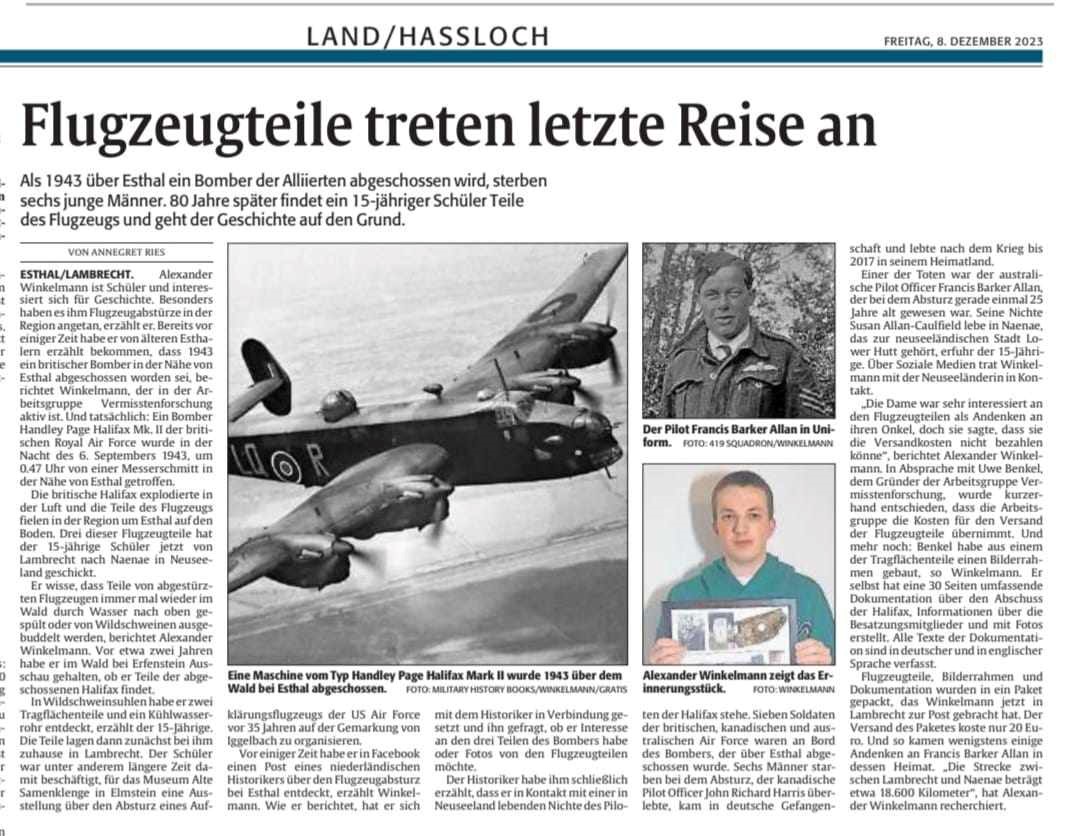
Aircraft parts start their final journey
A Royal Air Force Halifax bomber crashes near a small village in Germany in September 1943: 80 years later, a 15-year-old schoolboy sends parts of the plane to the pilot's niece in New Zealand.
Alexander Winkelmann is a student and is interested in history. He lives in Lambrecht, a town in Rhineland-Palatinate, Germany. He is particularly interested in plane crashes in the region, he says. Some time ago, he was told by older Esthal residents that a British bomber had been shot down near Esthal, reports Winkelmann, who is active in the "Arbeitsgruppe Vermisstenforschung". The "Arbeitsgruppe Vermisstenforschung" was founded in 1989 by Uwe Benkel and deals with the recovery of the remains of missing aircrew from the Second World War and the return of personal items, such as identification tags or aircraft parts, to relatives. And indeed: A Handley Page Halifax Mk. II bomber of the British Royal Air Force was hit by a Messerschmitt Bf 110 G-4 night fighter near Esthal on the night of September 6, 1943, at 0:47 am.
The British Halifax exploded in the air and the parts of the plane fell to the ground in the region around Esthal. The 15-year-old schoolboy has now sent three of these aircraft parts from Lambrecht (Palatinate) to Naenae in New Zealand.
Aircraft parts keep turning up in the forest
Alexander Winkelmann reports that he knows that parts of crashed airplanes are sometimes washed up in the forest by water or dug up by wild boars, of which there are many in the Palatinate Forest. About two years ago, he was looking in the forest near Erfenstein to see if he could find parts of the Halifax that had been shot down. He discovered two wing parts and a cooling water pipe in wild boar holes on the surface, says the 15-year-old. The parts were then initially left at his home in Lambrecht. Among other things, the schoolboy spent a long time organizing an exhibition for the Alte Samenklenge Museum in Elmstein about the crash of a U.S. Air Force reconnaissance plane 35 years ago in the Elmstein-Iggelbach district (16 kilometers from Lambrecht).
Contact with historian
Some time ago, Winkelmann says, he discovered a post on Facebook by a Dutch historian called Peter Clermonts about the plane crash near Esthal. He reports that he contacted the historian and asked him if he was interested in photos of the plane parts.
The historian eventually told him that he was in contact with a niece of the Halifax pilot living in New Zealand. Seven soldiers from the British, Canadian and Australian Air Force were on board the bomber that was shot down over Esthal. Six men died in the crash, the Canadian pilot Officer John Richard Harris survived, was taken prisoner by the Germans and lived in his home country after the war until 2017.
Pilot's niece lives in New Zealand
"The lady was very interested in the airplane parts as a souvenir of her uncle," reports Alexander Winkelmann. In consultation with Uwe Benkel, the founder of the "Missing Persons Research Group", it was decided that the group would cover the shipping costs, as is usual for them.
According to Winkelmann, Benkel built a picture frame from one of the wing parts. He himself created a 30-page documentary about the shooting down of the Halifax, with information about the crew members and photos. All texts in the documentation are in German and English.
Aircraft parts, the picture frame and documentation were packed in a package that Winkelmann brought to the post office in Lambrecht on November 28, 2023. And so at least some mementos of Francis Barker Allan arrived in his home country. "The distance between Lambrecht and Naenae is around 18,600 kilometers," Alexander Winkelmann has researched.'

